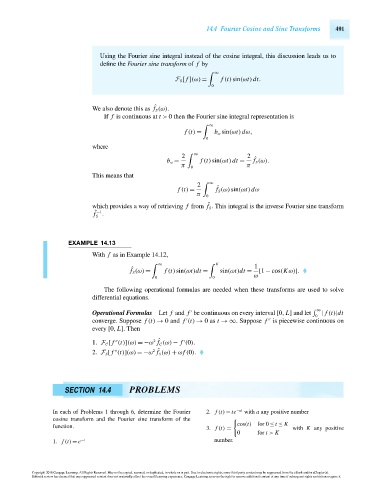Page 511 - Advanced engineering mathematics
P. 511
14.4 Fourier Cosine and Sine Transforms 491
Using the Fourier sine integral instead of the cosine integral, this discussion leads us to
define the Fourier sine transform of f by
∞
F S [ f ](ω) = f (t)sin(ωt)dt.
0
We also denote this as f S (ω).
ˆ
If f is continuous at t > 0 then the Fourier sine integral representation is
∞
f (t) = b ω sin(ωt)dω,
0
where
2 ∞ 2
ˆ
b ω = f (t)sin(ωt)dt = f S (ω).
π 0 π
This means that
2 ∞
ˆ
f (t) = f S (ω)sin(ωt)dω
π 0
ˆ
which provides a way of retrieving f from f S . This integral is the inverse Fourier sine transform
f ˆ S −1 .
EXAMPLE 14.13
With f as in Example 14.12,
∞ 1
K
ˆ
f S (ω) = f (t)sin(ωt)dt = sin(ωt)dt = [1 − cos(Kω)].
ω
0 0
The following operational formulas are needed when these transforms are used to solve
differential equations.
∞
Operational Formulas Let f and f be continuous on every interval [0, L] and let | f (t)|dt
0
converge. Suppose f (t) → 0 and f (t) → 0as t →∞. Suppose f is piecewise continuous on
every [0, L]. Then
2 ˆ
1. F C [ f (t)](ω) =−ω f C (ω) − f (0).
2. F S [ f (t)](ω) =−ω f S (ω) + ωf (0).
2 ˆ
SECTION 14.4 PROBLEMS
In each of Problems 1 through 6, determine the Fourier 2. f (t) = te −at with a any positive number
cosine transform and the Fourier sine transform of the
cos(t) for 0 ≤ t ≤ K
function.
3. f (t) = with K any positive
0 for t > K
1. f (t) = e −t number.
Copyright 2010 Cengage Learning. All Rights Reserved. May not be copied, scanned, or duplicated, in whole or in part. Due to electronic rights, some third party content may be suppressed from the eBook and/or eChapter(s).
Editorial review has deemed that any suppressed content does not materially affect the overall learning experience. Cengage Learning reserves the right to remove additional content at any time if subsequent rights restrictions require it.
October 14, 2010 16:43 THM/NEIL Page-491 27410_14_ch14_p465-504

